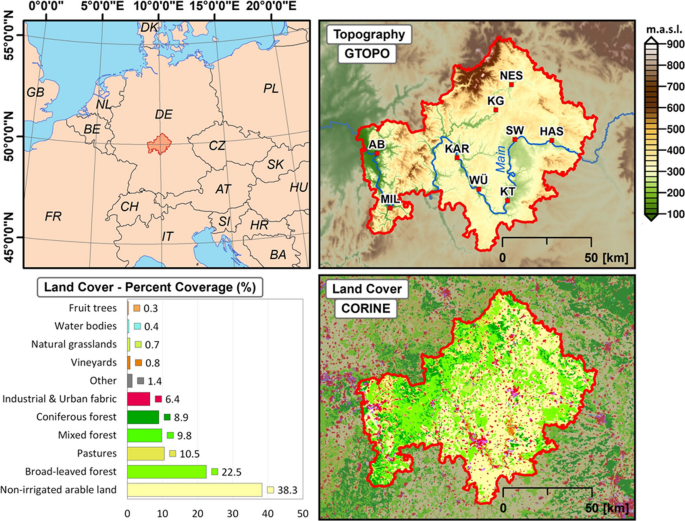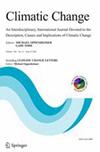Climate change information tailored to the agricultural sector in Central Europe, exemplified on the region of Lower Franconia
IF 4.8
2区 环境科学与生态学
Q1 ENVIRONMENTAL SCIENCES
引用次数: 0
Abstract
Abstract There is a growing societal, economic, and political demand to translate available data on regional climate change into sector-specific, practice-oriented, and user-friendly information. The study presents a demand-driven approach to specify the impacts of regional climate change on agriculture, viticulture, and fruit and vegetable growing in Lower Franconia, southern Germany, a region with heterogeneous topography, diversified land use patterns, and intense activities in the sectors specified above. The approach is based on an ensemble of high-resolution regional climate model projections, a bias correction tool, and a large spectrum of meteorological (extreme) indicators that are crucial to the agricultural sector in Central Europe, as inferred from a stakeholder survey. For several decades, Lower Franconia represents a hotspot region of climate change with enhanced heat waves, prolonged droughts, and intermittent local flooding by heavy rainfall events. Results of the high-resolution regional climate model projections indicate an increase of hot days and tropical nights by a factor of 5 and 12, respectively, if greenhouse gas emissions continue to grow until 2100 according to the RCP8.5 emission scenario. At the same time, droughts will occur more frequently and last longer while rainfall intensity enhances. A longer growing period starting more than 40 days earlier (compared to the reference period 1970 to 1999) implies a higher risk of late frost damage for crops, fruits, grapes, and even some tree species. In contrast, the thermal prerequisites for viticulture will be satisfied across the entire region, even at higher-elevation sites. These facets of regional climate change are made accessible to users and the public via an interactive field-resolving web portal. Altogether, they gravely challenge the historically developed land use systems in Lower Franconia and require timely adaptation and mitigation strategies.

为中欧农业部门量身定制的气候变化信息,以下弗兰科尼亚地区为例
将现有的区域气候变化数据转化为针对特定行业、面向实践和用户友好的信息的社会、经济和政治需求日益增长。该研究提出了一种需求驱动的方法来具体说明区域气候变化对德国南部下弗朗哥尼亚地区农业、葡萄栽培和水果蔬菜种植的影响,该地区具有异质地形、多样化的土地利用模式和上述部门的密集活动。该方法基于一系列高分辨率区域气候模式预测、偏差校正工具以及从利益相关者调查中推断出的对中欧农业部门至关重要的大量气象(极端)指标。几十年来,下Franconia代表了气候变化的热点地区,热浪增强,干旱延长,局部间歇性洪水由强降雨事件引起。高分辨率区域气候模式预估结果表明,如果温室气体排放继续增长到2100年,根据RCP8.5排放情景,炎热日数和热带夜数将分别增加5倍和12倍。与此同时,随着降雨强度的增强,干旱将更加频繁和持续更长时间。如果生长期提前40多天开始(与1970年至1999年的参考期相比),则意味着农作物、水果、葡萄甚至某些树种遭受晚霜损害的风险更高。相比之下,葡萄栽培的热先决条件将在整个地区得到满足,即使在高海拔地区也是如此。区域气候变化的这些方面通过一个交互式的领域解析门户网站向用户和公众开放。总之,它们严重挑战了下弗兰科尼亚历史上发达的土地利用系统,需要及时的适应和缓解战略。
本文章由计算机程序翻译,如有差异,请以英文原文为准。
求助全文
约1分钟内获得全文
求助全文
来源期刊

Climatic Change
环境科学-环境科学
CiteScore
10.20
自引率
4.20%
发文量
180
审稿时长
7.5 months
期刊介绍:
Climatic Change is dedicated to the totality of the problem of climatic variability and change - its descriptions, causes, implications and interactions among these. The purpose of the journal is to provide a means of exchange among those working in different disciplines on problems related to climatic variations. This means that authors have an opportunity to communicate the essence of their studies to people in other climate-related disciplines and to interested non-disciplinarians, as well as to report on research in which the originality is in the combinations of (not necessarily original) work from several disciplines. The journal also includes vigorous editorial and book review sections.
 求助内容:
求助内容: 应助结果提醒方式:
应助结果提醒方式:


